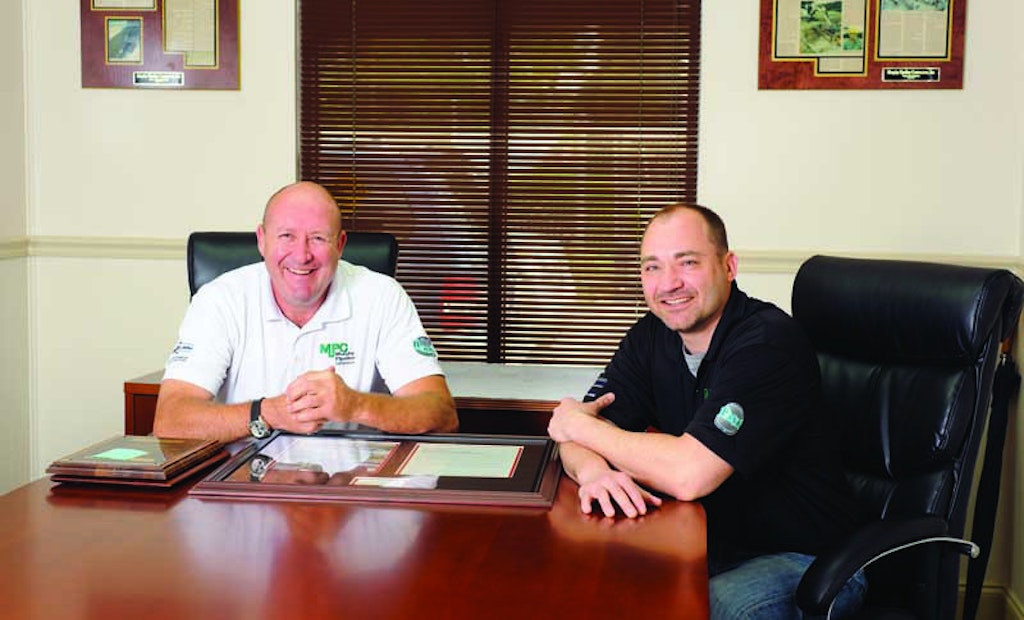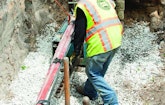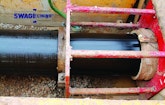
Interested in Relining/Rehab?
Get Relining/Rehab articles, news and videos right in your inbox! Sign up now.
Relining/Rehab + Get AlertsWhen Andy Mayer came to the United States from England in the late 1990s, he noticed the opportunity immediately. He had his first experience with pipe bursting and Swagelining two decades prior while working as a 16-year-old engineering apprentice for British Gas. But those technologies were nowhere near as advanced in the United States.
“A country as big as America was still putting 30-ton excavators with 4-foot buckets in subdivisions to install 6-inch pipe. It didn’t make any sense to me,” he says. “With my knowledge and background, it quickly turned into a no-brainer. There was an opportunity for trenchless technologies in the U.S., hence Murphy Pipeline was formed.”
It was 1999 and work was sporadic at first. Gradually, awareness about the technologies grew in the U.S. and Murphy Pipeline Contractors has grown right alongside it. The company’s proactive educational efforts have been key, not only for its own growth but also the trenchless industry as a whole.
“It all comes down to education and working with clients to explain the processes and the benefits,” Mayer says. “It’s taken about 15 years, but what I’ve seen in the U.S. — particularly with pipe bursting — is that trenchless technologies have become very accepted. It’s now gathering a lot of momentum.”
Coming to America
After completing his apprenticeship, Mayer remained with British Gas for about 10 years, then started his own company, AJM Consults & Engineers. A little more than a decade after that, Mayer found himself being recruited by HammerHead Trenchless Equipment to bring his expertise to the U.S.
“Initially it wasn’t to start up business and move here,” he says. “It was to help a Florida contractor break into the market. But I thought prechlorinated pipe bursting was being done, and it turns out it wasn’t. People had no idea what it was. There was a huge market potential in the U.S. and I just happened to be in the right place at the right time. I was going to be pretty individualistic in the U.S., whereas going back to England I would’ve been one of many.”
Targeting an untapped market meant starting out small. It was just Mayer and a few crew members, and prechlorinated pipe bursting being a new technology, Mayer first worked with the Florida Department of Environmental Protection and the American Water Works Association to get the method approved. It utilizes HDPE pipe that is disinfected and pressure tested above ground beforehand, allowing it to be put into service immediately after the burst and eliminating the need for temporary water services. Early projects were successful and from there it grew, beginning in Florida and then expanding throughout North America, serving mostly municipal customers.
Now there are about 60 employees companywide among three office locations — Milwaukee, Wisconsin; the Houston, Texas, area; and the headquarters in Jacksonville, Florida. Pipe bursting makes up most of the workload — about 80 percent. The company’s other specialties, Swagelining and sliplining, make up the remainder. Murphy Pipeline uses bursting equipment from TT Technologies and HammerHead Trenchless Equipment, and pipe fusion tools from McElroy. Most of the HDPE pipe and fittings come from ISCO Industries and Ferguson.
Growing Swagelining
Much of Murphy Pipeline’s growth has been in prechlorinated pipe bursting, but one of the biggest opportunities for future growth lies in the other specialty Mayer brought with him from England — Swagelining.
The technology is similar to sliplining: A new pipe is inserted into the original host pipe. But whereas sliplining reduces the interior diameter of the pipe, Swagelining maintains inside diameter and flow capacity.
“Say a client has a 42-inch water transmission line. We could slipline that with 36-inch pipe fairly easily,” says Todd Grafenauer, the company’s educational director. “But the challenge with that is you’re going to dramatically reduce flow. With Swagelining, we can actually select an HDPE pipe with an outside diameter larger than the host pipe. In the case of a 42-inch line we might select 44-inch HDPE. We’re pulling a bigger pipe inside a smaller pipe.”
That is accomplished by first passing the HDPE through a single reduction die, which temporarily reduces its size and allows it to be pulled through the host pipe. It remains in that state while the tension is maintained. After the pull is complete and that tension is released, the HDPE starts to expand until it’s stopped by the host pipe, producing a tight fit. Grafenauer says the value of Swagelining starts to come into play once pipes exceed 16 inches in diameter.
“You can definitely still use pipe bursting for larger diameters, but it becomes less cost-effective,” he says. “Once you get into water transmission mains where you’re looking at 16- up through 65-inch, that’s where Swagelining has really started to add value to our clients’ rehab programs.”
That’s also why the technology hasn’t yet taken off, says Grafenauer.
“These types of projects are a little more challenging because you’re dealing with some extremely high dollar amounts and long design periods,” he says. “When a community wants to replace a 6- to 8-inch water main, they can fund and design it in about three to six months. If you’re dealing with 5 miles of 54-inch pipe, that could take five years to design, fund and work out all the logistics.”
Even though it currently encompasses a smaller portion of the overall workload, Murphy Pipeline’s customer education efforts are just as invested in Swagelining. Mayer says the need for the technology already exists, and he thinks more people will realize that in the coming years.
“There are instances where a large-diameter pipe blows and causes a lot of pricey damage, and that’s spotlighting the need for this work,” Mayer says. “It’s only a matter of time before there will be a lot of this work, because it can be catastrophic. It’s not a 6-inch line in a subdivision where you just go in and take care of it. That’s not a big deal. If a 40-inch line blows downtown, that’s catastrophic. You’re talking millions of dollars.”
Mayer recalls one of the first significant Swagelining jobs Murphy Pipeline took on in 2011 in Amarillo, Texas. The method was used to rehab 5,300 feet of 30-inch cast iron water main originally installed in 1927. The construction footprint was tight since the pipe ran under homes and busy roads, and the city wanted to maintain flow capacity because the pipe was a critical artery within the water system. Swagelining was able to fit the needs of the project in a way other methods couldn’t.
“That was the first time anyone had ever Swagelined that size of pipe in the U.S.,” Mayer says. “It was a milestone for us, and that’s a project that always goes down as one of the most rewarding because we had a better solution for a municipality and they were willing to stick their necks out and let us work.”
Education is the key
Throughout the past 17 years, education has remained an integral part of Murphy Pipeline’s growth. Grafenauer leads those efforts from the company’s Milwaukee office.
“That’s primarily what my involvement has been since day one,” says Grafenauer, who was introduced to Mayer during one of the company’s first major projects. “It’s the first step we need to do before we can actually work, because human nature is what it is. People do things they’re comfortable with. Why are there communities that only do open cut? Because that’s the way they’ve always done it.”
A variety of different educational methods are used. Grafenauer often travels to potential customers’ locations to give technical presentations about the trenchless methods. He’ll cover the history of the technology, show videos of the work in progress, highlight actual case studies, explain the technology’s value from a construction and design standpoint, and spend time afterward answering questions. Murphy Pipeline will also hold “open days” at actual job sites and send out invitations so people can see the technology firsthand.
“We just did this recently for a 10,000-foot pipe bursting job in the Dallas-Fort Worth area,” Grafenauer says. “We invited cities and engineers from around Texas to come and see the technology in action. From that we got a good response and had well over 100 people just standing over the pit, watching crews pull the pipe into place. There’s tremendous value in that because not only do they see the method work, but they can also look at the areas where work has already been completed and see the kind of environment we left behind.”
Grafenauer says an open day at a job site can be the company’s most effective educational tool, and while he can’t put a hard figure on it, there’s a direct correlation between the amount of work Murphy Pipeline gets in a certain area and the number of open days that have been held there. While seeing the effectiveness of the technology firsthand may be a significant selling point, Grafenauer says Murphy Pipeline’s educational approach is a multistep process.
“The open day is an important step, but there’s a lot of work we do beyond that I believe is critical,” he says. “Maybe it’s the initial phone call with a potential client. We also get a ton of emails — just basic questions — and it’s important to get back to those people and spend the time to make sure they have the answers they were looking for.”
For contractors who rely heavily on customer education to ultimately sell their services, Grafenauer says it’s important to understand the full scope of what customers need to learn. During Murphy Pipeline’s early years, that meant focusing on the HDPE pipe material just as much as the actual bursting process.
“When I started doing this, before I could even talk to someone about our technologies, I had to cover the kind of pipe we install,” Grafenauer says. “For some communities, the conversation ended right there if they didn’t accept HDPE and were still stuck on installing ductile iron. What’s good to see is there are now some industry groups who are doing a phenomenal job with research and education about plastic pipe, such as the Plastics Pipe Institute. I don’t have to spend nearly as much time educating about HDPE anymore.”
He also says contractors should be prepared to do a certain amount of work up front with no guarantee that it will turn into a profitable job.
“A part of our education process when we’re looking at specific projects is feasibility,” he says. “We spend a lot of time with communities on the front end going through a feasibility analysis — which projects are good candidates, what risks might be present, and how can we mitigate those risks. Also involved in that is cost analysis and design guidance. But there’s no guarantee that you’re getting any work out of it. More often than not, it turns into a job. But if it doesn’t, we don’t have any issue with that. That’s what education is. It’s not about getting every job. We believe in the value of the technology and the proof is in the pudding — once you do work for somebody, how often do you go back and work for them? Almost every client we’ve ever worked with has had us back to do more work.”
The value of trenchless on display
One of Murphy Pipeline’s biggest early jobs had the company bursting 25,000 feet of pipe in the Florida Everglades. The prechlorinated pipe bursting method was still so new to the United States that company president Andy Mayer had to bring in workers from his home country of England, where the technology was better established, to fill out the crew. They had more than the typical job site challenges to deal with.
“We were just really happy to have a job of that size,” Mayer says. “We had our prejob meeting and I had all my people there, as well as a bunch of guys who had just gotten off a plane from England. There were park rangers who went through a list of animals in the Everglades that could kill us. They started with pythons and rattlesnakes, and we were sitting there and our eyes were wide. From there they moved on to crocodiles, caiman and alligators, saying that this was the only place in the world they all existed together, and our eyes grew wider.”
Despite the unusual work environment (one alligator earned the nickname Five O’Clock Freddy for his daily trek across the job site), the project was a success and the largest prechlorinated pipe bursting job in the U.S. at the time of its completion in 2003. Murphy Pipeline’s educational director, Todd Grafenauer, says it’s an example of the kind of value that can be achieved employing trenchless methods.
“Everglades National Park has some of the most endangered species of any park in the U.S., and when you look at how to replace water main in a park system like that, you need something that is fast and efficient, and will significantly reduce the amount of digging you do with open trench,” says Grafenauer. “I think it was a no-brainer for the parks system to use this kind of technology. That was a good project that served as a leaping stone for the company.”
More recently, Murphy Pipeline was involved in another pipe bursting project in a particularly sensitive area. In early 2015, the company wrapped up the latest phase of a water main replacement in Arlington National Cemetery. Beginning in 2012, Murphy Pipeline has burst 44,500 feet of pipe in the 624-acre site where more than 400,000 of the nation’s fallen soldiers are buried.
“Talk about an area needing a process that cannot impact the ground or disrupt operations,” says Grafenauer. “Every day there were 25 to 30 funerals.”
Crews stopped work and shut down equipment out of respect whenever a funeral procession passed, but without much advanced warning, it helped that the pipe bursting method produced minimal disruption to begin with.
“We burst in front of the Tomb of the Unknown Soldier. We burst in front of Kennedy’s grave. Some of the areas we were able to work were incredible,” says Grafenauer. “The value this technology has in an area like Arlington National Cemetery is why we do what we do.”












